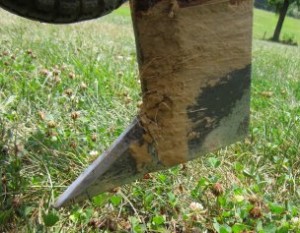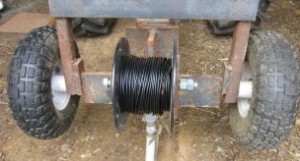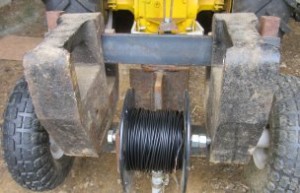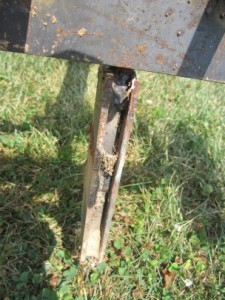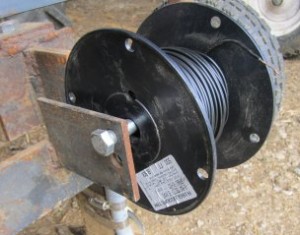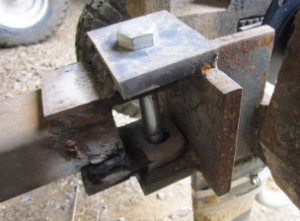Approximately 30 years ago we installed an underground “invisible” fence to contain our dogs. The fence encompasses several acres and requires a little over 1800 feet of wire in 500 foot sections. Over time the signal strength has slowly weakened and recently became too weak to contain our dogs. I checked the transmitter and it wasn’t the problem. I was sure the connections had become corroded over time and was the cause of the problem. I tried cleaning up some of the connections but that didn’t help. The wire was going to need to be replaced.
There’s a video of the attachment in the Videos section of this website.
When we installed the wire 30 years ago, they were two important differences. First, I was 30 years younger!! Second, I had two young sons that could crawl along on the ground and help bury the wire. We had used a Cub Cadet pulling a walk behind plow that I’d converted for the job. I’d removed the plow shovel and replaced it with a blade
 that made a “slot” in the ground so that the wire could be pushed by hand down into the bottom of the slot. That method no longer seemed too appealing.
that made a “slot” in the ground so that the wire could be pushed by hand down into the bottom of the slot. That method no longer seemed too appealing.
Note: As you read through this article and look at the pictures, you’ll notice that this attachment just sort of evolved. I used pieces of scrap metal I had laying around and kept adding pieces as the design got refined.
I was looking for something that would make the trench and apply the wire in one pass. After several iterations, I came up with attachment shown in the picture.
It’s mounted using the sleeve hitch on the tractor. I originally had only the “tongue” with the attached blade.
But when I tried it out it had a very inconsistent depth. In places it would dig in too deep and in other places it wouldn’t be deep enough. By making multiple passes to loosen the soil I could get enough depth everywhere but then most of the trench would be deeper than desired. The problem was overcome by adding the two wheels.
The wheels seemed to really help, but it required too many passes to get the depth I wanted. So I added a weight support and two 40 pound weights.
With the “digging” figured out, I worked on getting a method of applying the wire. I had thought ahead and made a slot in the rear of the blade that would help hold a 90 degree section of ½ inch PVC conduit.
I placed the section of conduit in the slot and secured it with hose clamps.
I added two plates to hold a pivot for the wire.
You might notice in the picture that there’s an extra hole for the bolt. That’s one of those things that “evolved” as I was refining the design. In the lower hole the reel is too close to the conduit.
I actually built this attachment about two years ago realizing the wire signal was weakening. It was in the Spring and everything seemed to work fine. But, when it actually came time to replace the wire, it was August. August is not a good time to work in the soil – the ground is dry and hard. I had originally made the attachment with a rear pivot for going around corners. When I tried it in the spring, everything worked fine. But with the hard ground in August, the rear section would lay “sideways” because of the added weights, and the point wouldn’t stick in the ground to straighten it back up. It would just drag sideways. So I welded the rear section in the straight ahead position. It made it a little more difficult to make corners, but the point was always straight ahead and would easily start penetrating the ground.
The other thing about working August is that the blade doesn’t just cut a slot. In the spring when the ground is moist, the blade simply makes a slot. The wire can even be applied in one pass. In August the hard ground tends to crumble to powder and grass roots tend to drag. It required two passes with just the blade before I could apply the wire. That was no biggie since I was just riding, but it is hot in August!!!
And, that’s it. The attachment worked great. I did have to spend a little more time back filling the trench since it was August, but that was a pretty simple, fast task. When I tried it out in the spring, I could just run my tractor wheel over the slot in the ground and the earth “squeezed” back together. In August, I had to walk along with a hoe and pull the dirt back over the slot. But, the wire didn’t need replacing in the spring. Too bad it didn’t go out then!!!
As always, I hope you found this article informative and useful. If you have any questions or comments, you can contact me through this website.

